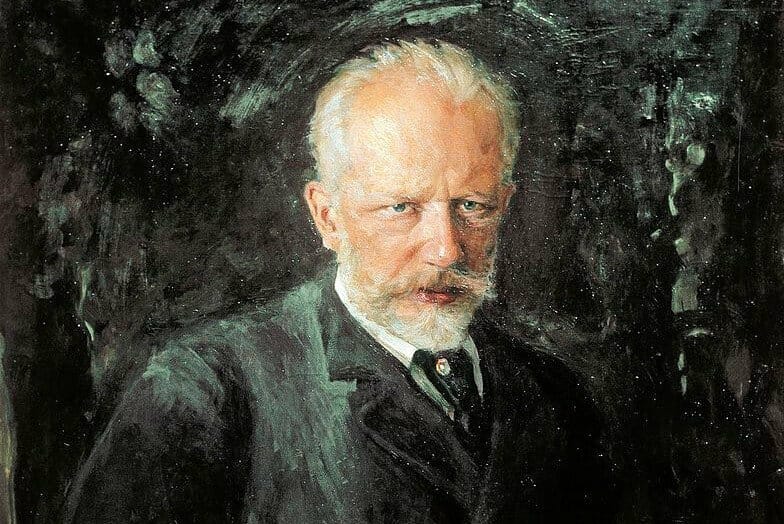Tchaikovsky’s First Piano Concerto: From Rejection to Triumph

Tchaikovsky’s Piano Concerto No. 1 in B-flat minor opens with one of the most powerful and iconic introductions in music history.
A mighty four-note descending line, stated three times in the horns, is punctuated by orchestral thunderbolts. A soaring and expansive theme emerges in the strings, accompanied by colossal ascending chords in the solo piano. Defying convention, this majestic and memorable theme opens the Concerto, yet never returns. Additionally, it sets up the wrong key—not the “home” key of B-flat minor, but its relative major, D-flat. Still, the Russian musicologist, Francis Maes, has written that “the opening melody comprises the most important motivic core elements for the entire work,” and “the themes of the three movements are subtly linked.”
Throughout this grand introduction, the solo piano inserts a cadenza which not only initiates motivic development, but also engages instruments of the orchestra in a playful and sneaky musical conversation. The exposition’s galloping first theme is based on a Ukrainian folksong. Tchaikovsky heard it performed near Kiev by a blind street musician who accompanied himself on the hurdy-gurdy. The second subject group brings two alternating themes. The second is filled with the kind of hushed atmosphere and magical colors that we hear occasionally in Tchaikovsky’s ballet music. In one passage (9:02), inner voices in the strings swoop and glide underneath the melody in the first violins in a way which evokes a sense of floating. When this theme returns in the recapitulation, it is cast anew with bright, dancing lines in the flutes (19:15). The first movement (Allegro non troppo e molto maestoso — Allegro con spirito) concludes with a virtuosic flourish, capped off with a triumphant plagal cadence.
The second movement (Andantino semplice — Prestissimo) returns to D-flat major. Its tender principal theme is introduced by the plaintive flute, accompanied by sparse string pizzicati. A moment later, the piano enters and a glistening new landscape emerges with gentle, veiled strings and the lamenting voice of the bassoon. The melody returns with new piano embellishments as soulful instrumental voices emerge one by one, including the horn, oboe, and solo cello. The Prestissimo middle section erupts with dazzling virtuosity and a quote of the French chansonette, Il faut s’amuser, danser et rire. (“One must have fun, dance and laugh”).
The final movement (Allegro con fuoco) is a ferocious and frolicking rondo based on an exuberant Ukrainian dance. The second theme was inspired by the Russian folksong, Poydu, poydu vo Tsar-Gorod (“I’m Coming to the Capital”). In the movement’s coda section, elements of the two themes combine amid an awe-inspiring buildup of tension. The release comes with the full orchestra’s majestic final statement of the second theme in B-flat major. The exhilarating final bars leap towards the concluding cadence.
Now a staple of the repertoire, Tchaikovsky’s First Piano Concerto became the first piece of classical music to sell a million records following the release of Van Cliburn’s 1958 album. Yet, the revered pianist, Nikolay Rubinstein, was unimpressed when he was first introduced to the newly completed work on Christmas Eve of 1875. A close and usually supportive friend of the composer, Rubinstein conducted many of Tchaikovsky’s works, including the premiere of the opera, Eugene Onegin. In a letter, Tchaikovsky described the encounter:
I played the first movement. Not a single word, not a single remark! If you knew how stupid and intolerable is the situation of a man who cooks and sets before a friend a meal, which he proceeds to eat in silence! Oh, for one word, for friendly attack, but for God’s sake one word of sympathy, even if not of praise…It turned out that my concerto was worthless and unplayable; passages were so fragmented, so clumsy, so badly written that they were beyond rescue; the work itself was bad, vulgar; in places I had stolen from other composers; only two or three pages were worth preserving; the rest must be thrown away or completely rewritten. “Here, for instance, this—now what’s all that?” (he caricatured my music on the piano) “And this? How can anyone …”
Defiantly vowing that he would “not alter a single note,” Tchaikovsky dedicated the Concerto to the German pianist Hans von Bülow, who gave the premiere on tour in Boston on October 25, 1875. Three years later, Tchaikovsky was “very, very pleased” to learn that Rubinstein, having changed his opinion, had performed the Concerto in Moscow, Saint Petersburg, and Paris.
This spectacular recent performance features the French-Georgian pianist, Khatia Buniatishvili, with Klaus Mäkelä and the Orchestre de Paris:
Five Great Recordings
- Van Cliburn with Kiril Kondrashin and the RCA Symphony Orchestra
- Martha Argerich with Claudio Abbado and the Berlin Philharmonic
- Daniil Trifonov with Valery Gergiev and the Mariinsky Orchestra
- Vladimir Ashkenazy with Lorin Maazel and the London Symphony Orchestra
- Anna Fedorova with Yves Abel and the Nordwestdeutsche Philharmonie
This article first appeared on The Listeners’ Club.





